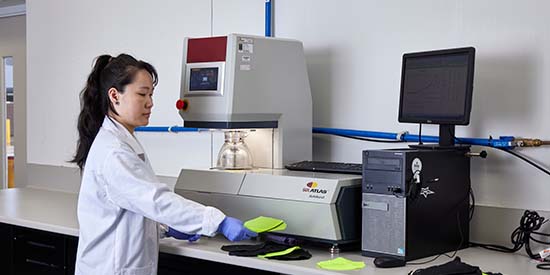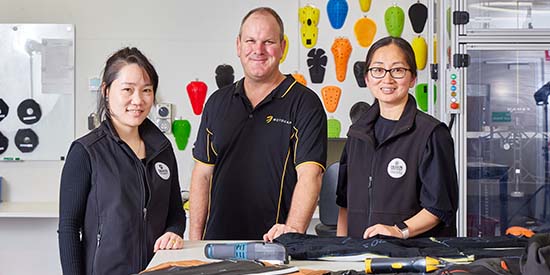How safe is women's motorcycle gear? Deakin textile experts put it to the test
Research news
Summary:
- Deakin University scientists have revealed how protective women’s motorcycle leggings really are, thanks to the Motorcycle Assessment Clothing Program (MotoCAP).
- Alarmingly, seven out of ten women’s motorcycle leggings and jeggings brands tested only scored half a star for protection.
- Deakin’s Associate Professor Christopher Hurren urges motorcyclists across Victoria to wear all the gear, all the time and to check the MotoCAP ratings.
In 2021-22, 24% of people seriously injured on Australian roads and requiring hospitalisation were motorcyclists.
There is strong evidence to suggest wearing protective motorcycle gear can significantly reduce injuries in the event of an accident.
The massive levels of variation in protection of motorcycle clothing sold in Australia make choosing the right riding gear fraught with danger.
New research by Deakin University textiles experts reveals a popular gear choice for female motorcyclists – leggings and jeggings – offers dangerously low levels of protection. The rigorous scientific testing was conducted by the Motorcycle Assessment Clothing Program (MotoCAP) based in Deakin’s Institute for Frontier for Materials.
What did our researchers find?
Deakin’s textile experts at MotoCAP tested 10 different brands of women’s motorcycle leggings and jeggings sold in Australia. They found seven out of 10 brands scored only half a star for protection.
- Poor abrasion resistance
Abrasion injuries are one of the most common in a motorcycle accident with scrapes, cuts, and grazes of all shapes and sizes.
Eight of the 10 protective leggings and jeggings tested scored poorly in abrasion resistance.
This means the leggings are wearing through before you’ve finished sliding after an accident and your skin is at risk of being shredded by the road.
Additionally, in the brands that used higher resistance materials, the protective fabrics didn’t cover all the high-risk abrasion areas such as knees, sides of the legs and backside.
- Substandard seams and burst resistance
Seam strength can be the only thing standing between you and potentially life-threatening injuries during a motorcycle accident if your gear’s burst resistance isn’t up to scratch.
The Deakin researchers’ tests revealed that the seam strength and burst resistance of eight of the women’s protective leggings and jeggings evaluated were either marginal or poor.
Flimsy fabrics and inappropriate seam selection contribute to the likelihood of bursting on impact and leaving you exposed to the road surface.
- Inadequate impact protection
When you hit the ground, one of the first areas to bear the brunt on impact can often be the hips or knees, making impact protection in your safety gear critical.
Seven out of 10 women’s motorcycle protective leggings and jeggings tested by MotoCAP scored poorly on impact protection, with these brands offering no hip or knee impact protection whatsoever.
Impact injuries on the lower extremities can be a serious matter. Without the right protection, they can result in broken bones, complex injuries, extensive and painful recoveries, limited mobility, and soft tissue damage.

Deakin textile experts putting fabrics to the test.
How to have a safer ride
The variation in protection levels in motorcycle clothing means that riders are unknowingly choosing style over safety and are forced to rely on marketing spin and online reviews to make their purchase decisions.
Choosing high quality protective riding gear and dodging the poor performers involves digging deeper into the types of materials, seam quality and impact protection levels in each garment.
MotoCAP conducts independent scientific testing of gear sold in Australia and New Zealand to provide consumers with star ratings on the performance of motorcycle jackets, pants and gloves.
‘We recommend wearing at least two -star plus garments for city riding, and three-star plus garments for open road riding to help reduce the risk of injuries in the event of an accident,’ says Associate Professor Christopher Hurren, who is the Chief Scientist for the MotoCAP program.
All the gear, all the time
Finding the perfect motorcycle protective gear can be challenging and confusing.
A keen motorcyclist himself, Associate Professor Hurren says it can be tempting to forget the gear entirely, especially if you know it doesn’t offer protection.
‘If you’ve gone onto the MotoCAP website and found out your gear isn’t protective, don’t stop wearing it. Any gear, even if it is low performing, is better than riding in no gear,’ he says.
‘Good protection levels can often be found with a leather jacket, protective denim jeans, long cuff gloves, riding boots and a helmet.
Want to choose the right motorcycle gear for your ride? Compare breathability and safety ratings with the free, independent MotoCAP site.
About Associate Professor Christopher Hurren

Associate Professor Hurren has led the design and implementation of the award-winning MotoCAP program at Deakin’s Institute for Frontier Materials since 2016. His key areas of research are the development of protective and performance textiles and a circular approach to sustainable textiles. He specialises in the measurement and development of protective structures for motorcycle apparel. His laboratory at Deakin’s Waurn Ponds Campus is set up for the design and evaluation of new protective motorcycle clothing.
- Chief Scientist for the MotoCAP program.
- Winner of the 2019 Federation Internationale de Motocyclisme (FIM) Road Safety Award – MotoCAP project.
- Winner of the 2018 Land Forces Conference National Innovation Award in the Combat Equipment and Mobility category.
- Winner of the 2017 H&M Foundation Global Change Awards with the “Denim Dyed Denim” project.
- Winner of the 2010 ‘Save the Planet’ category in the Smart Geelong Research Network Awards.
- Chief Scientist for the MotoCAP program.
- Author of A guide to designing and manufacturing motorcycle protective clothing
- Supported as a technical consultant on TAC 2022 ad campaign, as well as working with the Victorian Government on a road abrasion program.
More information
For a deeper dive into MotoCAP's research, watch more.
The text of this article is licensed under the Creative Commons Attribution (CC BY) 4.0 International license. We'd love for you to share it, so feel free! Please note that images, videos, graphics and logos are not covered by the CC BY license and may not be used without permission from Deakin University or their respective copyright holder. If you have any questions please contact researchcomms@deakin.edu.au. Thanks for reading!
You can find more stories like this at https://www.deakin.edu.au/research/research-news-and-publications. We ask that Deakin University and individuals are appropriately credited and that you include links back to this website. Quotes in this article can be extracted for other articles provided individuals are appropriately credited and you include a link back to the article URL.
Share this story

Key Fact
Deakin’s textile experts found seven out of 10 women’s motorcycle leggings and jeggings brands tested scored only half a star for protection.
